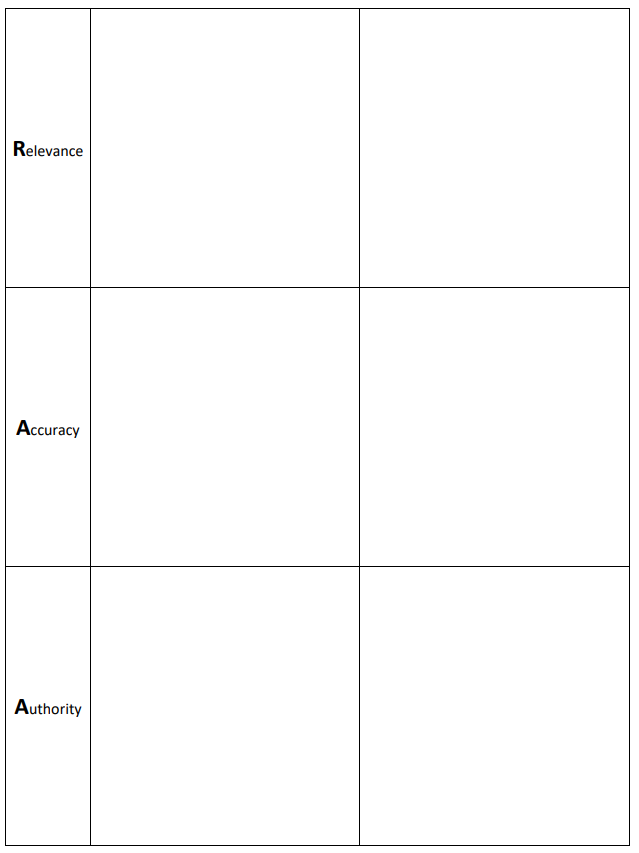3.3.3: Activities
( \newcommand{\kernel}{\mathrm{null}\,}\)
Activities
Research Scavenger Hunt
To practice using a variety of research tools and finding a diversity of sources, try to discover resources according to the following constraints. Once you find a source, you should make sure you can access it later- save it to your computer, copy a live, stable URL; request it form the library; and/or save it to your Library eShelf, if you have one. For this assignment, you can copy a URL or doi for digital resources or library call number for physical ones.
If you're already working on a project, use your topic for this activity. If you don't have a topic in mind, choose one by picking up a book, paper, or other written text near you: close your eyes and point to a random part of the page. use the noun closest to your finger that you find vaguely interesting as a topic or search term for this exercise.
Exercise


Identifying Fake News
To think more about credibility, accuracy, and truth, read "Fake news 'symptomatic of crisis in journalism'" from Al Jazeera. Then, test your skills using this fake news quiz game.
Interacting with Sources Graphic Organizer
The following graphic organizer asks you to apply the skills from the previous section using a text of your choice. Complete this graphic organizer to practice critical encounters with your research and prepare to integrate information into your essay.
Exercise






Articulating Your Claim- Practice Thesis Development
To practice applying the strategies for developing and revising a thesis statement explored in this chapter, you will write and revise a claim based on constraints provided by your groupmates. This activity works best with at least two other students.
Part One- Write
First, on a post-it note or blank piece of paper, write any article of clothing. Then, choose one type of claim (Claim of Phenomenon, Claim of Evaluation, or Claim of Policy, introduced in "Research Methods: Drawing from Sources and Synthesizing") and write "Phenomenon," "Evaluation," or "Policy" on a different post-it note or blank piece of paper.
Exchange your article of clothing with one student and your type of claim with another. (As long as you end up with one of each that you didn't come up with yourself, it doesn't matter how you rotate.) Now, write a thesis statement using your choice of strategy:
- T3 (Throughout history, women have been legally oppressed by different social institutions, including exclusion from the workplace, restriction of voting rights and regulations of healthcare.)
- O/P (Recent Congressional activity in the U.S. has led me to winder how women's freedoms have been restricted throughout history. Women have been legally oppressed by many different institutions since the inception of the United States.)
- Embedded Thesis (Many people would agree that women have experienced oppression throughout the history of the United States, but how has this oppression been exercised legally through different social institutions?)
Your thesis should make a claim about the article of clothing according to the post-its you received. For example,

Now that it's November, it's time to break out the cold weather clothing. When you want to be both warm and also fashionable, a striped wool sweater is the best choice.
Part Two- Revise
Now, write one of the rhetorical appeals (logos, pathos, or ethos) on a new post-it notes. Exchange with another student. Revise your thesis to appeal predominantly to that rhetorical appeal.
|
Original: Now that it's November, it's time to break out the cold weather clothing. When you want to be both warm and also fashionable, a striped wool sweater is the best choice. |
 |
Revised: With the colder months looming, we are obliged to bundle up. Because they help you maintain consistent and comfortable body temperature, wool sweaters are the best option. |
Finally, revise your thesis once more by adding a concession statement.
|
Original: With the colder months looming, we are obliged to bundle up. Because they help you maintain consistent and comfortable body temperature, wool sweaters are the best option. |
Revised: With the colder months looming, we are obliged to bundle up. Even though jackets are better for rain or snow, a sweater is a versatile and functional alternative. Because they help you maintain consistent and comfortable body temperature, wool sweaters are the best option. |
Guiding Interpretation (Readerly Signposts)
In the organizer on the next page, create a signpost for each of the quotes in the left column that reflects the posture in the top row.
Exercise





